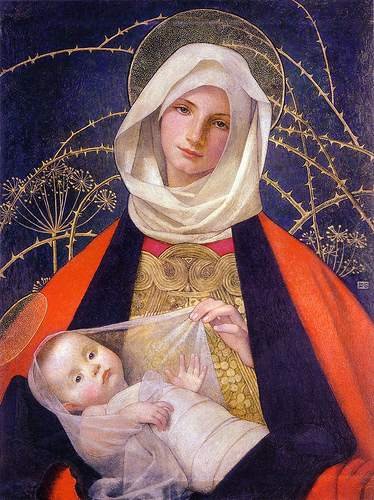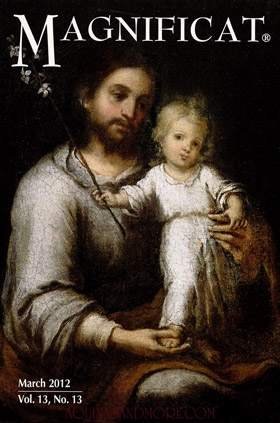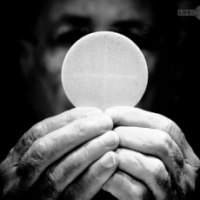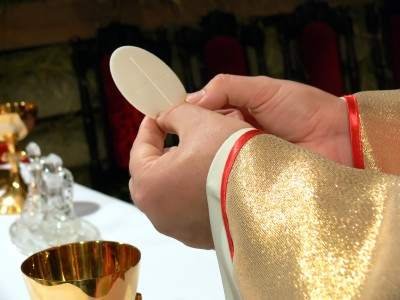
Madonna and Child, by Marianne Stokes (1855-1927). This painting was on the cover of Magnificat last December and I like it a lot.
The Church designates each Saturday in Ordinary Time, when there is no other obligatory memorial, as a memorial to the Blessed Virgin Mary. (Celebrations on the liturgical calendar have three ranks: solemnities, feasts, and memorials; memorials being the least important of the three. See the General Norms for the Liturgical Year and the Calendar III. For more on the dedication of Saturdays to Mary, see the Directory on Popular Piety and the Liturgy §188.) So, I’ve been thinking I would begin quoting some of the Church Fathers’ testimonies to the very early devotion to Mary. As historical and as important as these are, many of them are also poignant, moving, and very beautiful. From the earliest days of the Church, the Mother of Our Lord has been beloved and honored.
I’m working on a Bible study that I think will knock some socks off; that won’t be ready for another day or two. I also wanted to ask you all to pray for the peace and comfort of a dear, dear friend of mine who lost her father very suddenly yesterday, and for the repose of his soul.
Here is a reading from St. Athanasius of Alexandria (c. 297–373):
O noble Virgin, truly you are greater than any other greatness. For who is your equal in greatness, O dwelling place of God the Word? To whom among all creatures shall I compare you, O Virgin? You are greater than them all. O [Ark of the New] Covenant, clothed with purity instead of gold! You are the Ark in which is found the golden vessel containing the true manna, that is, the flesh in which divinity resides. Should I compare you to the fertile earth and its fruits? You surpass them, for it is written: “The earth is my footstool” (Isaiah 66:1). But you carry within you the feet, the head, and the entire body of the perfect God.
If I say that heaven is exalted, yet it does not equal you, for it is written: “Heaven is my throne” (ibid.), while you are God’s place of repose. If I say that the angels and archangels are great — but you are greater than them all, for the angels and archangels serve with trembling the One who dwells in your womb, and they dare not speak in his presence, while you speak to him freely.
If we say that the cherubim are great, you are greater than they, for the cherubim carry the throne of God (cf. Psalm 80:1, 99:1), while you hold God in your hands. If we say that the seraphim are great, you are greater than them all, for the seraphim cover their faces with their wings (cf. Isaiah 6:2), unable to look upon the perfect glory, while you not only gaze upon his face but caress it and offer your breasts to his holy mouth . . .
As for Eve, she is the mother of the dead, “for as in Adam all die, even so in Christ shall all be made alive” (1 Corinthians 15:22). Eve took [fruit] from the tree and made her husband eat of it along with her. And so they ate of that tree of which God had told them: “The day you eat of it, you shall die” (Genesis 2:17). Eve took [fruit] from it, ate some of it, and gave some to her husband [that he might eat] with her. He ate of it, and he died.
In you, instead, O wise Virgin, dwells the Son of God: he, that is, who is the tree of life. Truly he has given us his body, and we have eaten of it. That is how life came to all, and all have come to life by the mercy of God, your beloved Son. That is why your spirit is full of joy in God your Savior!
—St. Athanasius
Homily of the Papyrus of Turin
(ed. T. Lefort, in Le Muséon 71 (1958): 216–217)
in Luigi Gambero, Mary and the Fathers of the Church
(San Francisco: Ignatius, 1991), 106–107
The Body and Blood of Christ
Today at Mass we celebrated the Feast of Corpus Christi, the Solemnity of the Most Holy Body and Blood of Christ. According to the Roman Missal, the actual date of the feast worldwide was last Thursday, the Thursday after Trinity Sunday; but in countries in which Corpus Christi is not a Holy Day of Obligation, including the United States, it is commuted to the following Sunday. In short, I get a slight reprieve for forgetting to blog about it on Thursday.
Corpus Christi celebrates the Real Presence of Christ in the Eucharist. Brad made a brilliant and fascinating post over at SFC on the historical origins of Corpus Christi, to which there is little I can add. But in the spirit of my own blog, I wanted to say a few words about my journey toward a belief in the Real Presence, and share my own tribute.
The Doctrine of the Real Presence in Scripture and Theology
First, what do I mean by “Real Presence”? I take for granted that most people know, but I certainly didn’t until I studied the Church in school. Catholics (and Orthodox, too) believe and affirm that Christ’s Body and Blood are really present in our Eucharist — that our Eucharist, or Holy Communion, is not just bread and wine, but that by the grace of the Holy Spirit, the elements actually become the Body and Blood of Christ. I am not theologian enough to argue to the fine point of transubstantiation, but it amounts to this: we believe that the substance of the the bread and wine change into the substance of the Body and Blood of Christ; while everything that we can see, feel, smell, and taste (the appearances, or species in Latin) remains the same. Christ’s Body and Blood are contained in the Eucharist, under the forms of the bread and wine. Father Joe has a great, accessible post from a week or two ago on the doctrine of transubstantiation, St. Justin Martyr, and St. Thomas Aquinas.
Many Protestants, on the other hand, believe that Holy Communion, the Lord’s Supper, is only a symbol or memorial. Others, like Lutherans, Anglicans, and Methodists, have varying ideas about the Real Presence. Growing up, I was taught that it was only a memorial, though the doctrine was never clearly stated. “Do this in remembrance of me,” Christ said in St. Paul’s account of the institution of the Eucharist. “As often as you eat this bread and drink the cup, you proclaim the Lord’s death until he comes” (1 Corinthians 11:23-26): these are the verses that were always emphasized. I frankly, now, have a very difficult time understanding how Protestants can read even this passage (and especially the parts before and after it) as describing anything but a real, actual presence of Christ in the Eucharist; let alone the passages in when Jesus was describing it (Matthew 26:26-28, Mark 14:22-24, Luke 22:17-20, and especially John 6:22-59). I simply don’t see any other way to interpret it than as the Eucharist being Christ’s Body and Blood. I would be very happy if some of my Protestant friends could discuss that with me (civilly and, I hope, productively).
I’ve posted about the Real Presence before, and gave some important proof texts attesting to the very early belief in the Real Presence. It is very clear that St. Paul, the Apostles, and their followers all believed the Eucharist to be much more than a symbol. How did Protestants fall away from a belief in the Real Presence? I know Luther rejected transubstantiation, but affirmed a different idea of the Real Presence. Did Calvin reject the Real Presence? According to the wiki, Calvin rejected a real, physical presence, but still affirmed a definite spiritual presence. Apparently we owe the view that the Eucharist is only a memorial to Zwingli. Many thanks to the wiki.
The Real Presence in My Journey of Faith
Growing up, despite believing that Communion was only a symbol, it was always an occasion for solemn reflection. The churches I was a part of never had Communion with particular frequency; only about once a month (I suppose the Methodists had it every week). It was in college, as I learned about the Church in history classes, that I first learned of the Catholic doctrine of the Real Presence. And immediately, I admired it, and somehow longed for it, long before I even realized I was longing for it: it was something real, something substantial, something tangible; something more than I was getting: a way to actually touch the presence of my Lord. Every time we took Communion after that, I began receiving it with the idea of “what if” this is really Jesus; until I began to think that “I want” it to really be Jesus.
It wasn’t until I was halfway converted already that I realized how wrong it was that I admired the Church Fathers so much, while discounting so much of what they believed, including the Real Presence. And by that time, there was no turning back. So much of my belief in Catholic doctrine was less a process of having to be convinced, than of acknowledging that the Catholic Church was the True Church, and belief in its doctrine falling in line after that.
Eucharistic Hymns
Before I close, let me share with you a couple of my favorite reflections on the Real Presence in the Eucharist. I have always loved Ave verum corpus, even long before I was Catholic, especially through Mozart’s setting:
St. Thomas Aquinas’s Adoro te devote is also very important to me, reminding me that even though what we see is bread — even though even the most brilliant minds may doubt — it is our Lord beneath the species:
I devoutly adore you, O hidden Deity,
Truly hidden beneath these appearances.
My whole heart submits to you,
And in contemplating you,
It surrenders itself completely.
Sight, touch, taste are all deceived
In their judgment of you,
But hearing suffices firmly to believe.
I believe all that the Son of God has spoken;
There is nothing truer than this word of truth.
On the cross only the divinity was hidden,
But here the humanity is also hidden.
I believe and confess both,
And ask for what the repentant thief asked.
I do not see the wounds as Thomas did,
But I confess that you are my God.
Make me believe more and more in you,
Hope in you, and love you.
(There is more).
Saint Joseph’s Day
Today is Saint Joseph’s day, my name day. But now is probably the time to note how completely out to sea I feel in many aspects of Catholic culture.
I don’t entirely understand how “patron saints” work, for churches and institutions, but particularly for individuals. Is there some formal process by which a patron saint is declared? Or is someone a “patron” just because I declare it so, because I ask them in particular to look out for me and pray for me? Are they exclusive? Can I have only one, special patron? Or can I fill my bucket with all my favorite saints I would like to have covering my back, and call them all my patrons? Do they have any particular say in the matter? Is it like choosing an academic advisor; in which case they might decide that their docket is full, and that they can’t afford to take any more advisees? Or do saints in heaven literally have all the time in the world, being outside our understanding of time? Is it, as I’ve heard many people say, a matter of the saint choosing us — much as “the wand chooses the wizard” in the world of Harry Potter?
In many cultures and many times over history, I know, children were often named for the saint on whose feast day they were born — joining their name day and their birthday. For children who are born Catholic, is their patron saint generally the saint for whom they are named? (In that case, what about children given more modern, non-saintly names?) Or do they, as I will, choose their own patron saint at their confirmation? Are there any particular customs attached to the celebration of the feast day of an individual’s patron saint?

Bartolomé Esteban Murillo (1617-1682), Saint Joseph and the Child Jesus, on the cover of this month's Magnificat.
St. Joseph. He is a saint held in especially high regard in the Catholic Church, being the adoptive father of Our Lord, the spouse of Our Lady, and the head of the Holy Family. I learned only today that he is the patron of the Catholic Church. I was gratified when it occurred to me, some months into this process, that my pastor, my bishop, and my pope all share my birth name. I noticed, on Rome Reports, that today is “the pope’s feast day.” Is this by virtue of his name being Joseph, of St. Joseph being his personal patron saint, or of his being pope? Or all of the above?
I really struggled, some months ago, with accepting many of the Marian beliefs. And conjoined to this was the idea of St. Joseph as Mary’s “most chaste spouse” — a notion, like Mary’s Perpetual Virginity, that is very foreign to the Protestant mind. For Protestants especially, Joseph becomes an everyman — just an average joe who received a very special calling from God. He becomes the typical dad and family man. For Catholics, too, he is held up as the exemplary family man, the patron of both fathers and workers; but Catholics ascribe a very atypical degree of righteousness and virtue to this man. Because the Holy Family is in no way a typical family. Not only is the wife the Most Blessed Virgin and Mother of God, and the son Our Lord and Savior, the Eternal Son of God — but St. Joseph has to be an incredible sort of man to put up with all this.
For Protestants, it is much simpler, because Mary, too, is just an average girl who was incredibly used of God. Joseph and Mary become the typical married couple, sharing a typical marriage with each other, which includes a sexual union and other children. To Catholics, the Holy Family models the relationships of Father and Mother to Son and Church; but beyond that, it little resembles any one of our earthly families. It has no sexual component. Two of its three members are most holy and without sin. Joseph becomes the “most chaste spouse” who, after a betrothal to a girl he desired to marry, never experiences sexual union with her at all.
The image of St. Joseph as a man changes considerably for Catholics. He is a much older man, already advanced in years, possibly a widower with other children. I have heard various interpretations and explanations of the “brothers and sisters” or “brethren” of the Lord — that they were Joseph’s children by his prior marriage, or that they were Jesus’s cousins or other close relatives — but the agreement for Catholics is that they were not the children of Mary. As an older man, Joseph wouldn’t have experienced particular hardship in forgoing sexual union. He becomes the guardian and protector of both Jesus and the young Blessed Virgin, taking Jesus as his adoptive son and Mary effectively as his ward. He is willing to do these things because he is a righteous man willing to lay down himself to serve God. He truly earns his sainthood; for the kind of man he was, not merely for the unique position he was in.
And so, St. Joseph is somebody I’m having to get to know all over again, like the Blessed Virgin Mary, whose place in my life I am still trying to find. I find myself having a difficult time relating to him; but he is certainly someone I must admire and venerate.
Poor Saint Valentine
This morning, picking myself up off the ground and climbing back on my horse yet again, I happened to glance a few pages back in my Magnificat, and take a look at the liturgical calendar.
In my anxiety to avoid all the glut and glurge of St. Valentine’s Day the other day, I had neglected to realize that St. Valentine’s Day, by far the most popularly known and universally celebrated saint’s day on the calendar — isn’t actually on the calendar. Or rather, it’s not on the general calendar. St. Valentine is not the saint that’s recommended for all churches to celebrate at Mass that day. Instead, that’s Saints Cyril and Methodius, two saints I’m rather fond of, and would have found a lot of comfort in commemorating. In addition to being great heroes of the faith, they invented an alphabet!
But St. Valentine. If you ask a typical Protestant to name a saint’s feast day, they will almost certainly name St. Valentine’s Day. It’s on most secular calendars. But not on ours, the place I would have expected to find it most prominently? My curiosity piqued, I turned to the place I knew would have an interesting and informative post: Brad at Southern Fried Catholicism.
The story was far richer, and more gratifying to a Valentine’s hater, than I could have imagined. As it turns out, there are more than a dozen saints named Valentine (the name, Valentinus, stemming from Latin valens, meaning “strong, powerful”), and popular culture celebrates entirely the wrong one on February 14, subjecting a perfectly innocent and worthy third century martyr to association with cheap love, cheesy cards, and mass-produced candy, thanks to a famous mistake involving Geoffrey Chaucer, King Richard II, and later lovestruck Victorians. With so much uncertainty and so much confusion (and, I like to think, a bit of Catholic disgust for the popular holiday, too), the Church under Pope Paul VI removed the festival from the general calendar in 1969. May St. Valentine — the real St. Valentine — any one of them, or all of them — please pray for us, and all the people left feeling lost and lonely by this unfortunate celebration.




